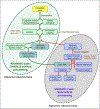Is navigation in virtual reality with FMRI really navigation?
- PMID: 23489142
- PMCID: PMC10271117
- DOI: 10.1162/jocn_a_00386
Is navigation in virtual reality with FMRI really navigation?
Abstract
Identifying the neural mechanisms underlying spatial orientation and navigation has long posed a challenge for researchers. Multiple approaches incorporating a variety of techniques and animal models have been used to address this issue. More recently, virtual navigation has become a popular tool for understanding navigational processes. Although combining this technique with functional imaging can provide important information on many aspects of spatial navigation, it is important to recognize some of the limitations these techniques have for gaining a complete understanding of the neural mechanisms of navigation. Foremost among these is that, when participants perform a virtual navigation task in a scanner, they are lying motionless in a supine position while viewing a video monitor. Here, we provide evidence that spatial orientation and navigation rely to a large extent on locomotion and its accompanying activation of motor, vestibular, and proprioceptive systems. Researchers should therefore consider the impact on the absence of these motion-based systems when interpreting virtual navigation/functional imaging experiments to achieve a more accurate understanding of the mechanisms underlying navigation.
Figures

References
-
- Angelaki DE, & Cullen KE (2008). Vestibular system: The many facets of a multimodal sense. Annual Review of Neuroscience, 31, 125–150. - PubMed
-
- Bassett JP, Zugaro MB, Muir GM, Golob EJ, Muller RU, & Taube JS (2005). Passive movements of the head do not abolish anticipatory firing properties of head direction cells. Journal of Neurophysiology, 93, 1304–1316. - PubMed
Publication types
MeSH terms
Grants and funding
LinkOut - more resources
Full Text Sources
Other Literature Sources

